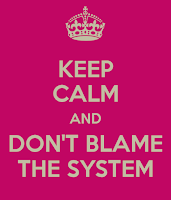W. Edwards Deming's taught us that, in his
experience, 94% of the problems are with the system [1]. Because of this and other experience, a vast
majority of the time our reaction is to blame the system. Here is the problem; systems
are neither good nor bad. We utilize systems that give the output we want, we
change the systems that do not give the output we want. Systems do not have
feelings, they do not try to trick us, they just exist and operate. Our job is
to review the systems we work within and determine if it is giving the desired
output. If not, what is the right
adjustment.
 Let's use the example of controlling traffic flow. Traffic lights or semaphores are
traditionally used, especially in the US, to control the flow of traffic. Drivers
responding to the lights and surrounding traffic conditions to control traffic
flow is a system. We know how to work within the system based on the lights, we
can either proceed, proceed with caution, or stop and wait for the light to
change. But when we look at that system we realize that it's not giving us the
output we want. The current system has cars sitting at a red light
while there's no traffic coming from the other direction, slows us down,
increases potential for accidents, and (potentially) increasing our carbon output.
Rather than blame the traffic light system, we need to change the system. If the output we want from the system is
improved traffic flow, improved safety, and decreased impact on the environment
then we change the system accordingly. By
understanding the system’s current output, and the delta to the desired output,
we can choose to change the system.
Let's use the example of controlling traffic flow. Traffic lights or semaphores are
traditionally used, especially in the US, to control the flow of traffic. Drivers
responding to the lights and surrounding traffic conditions to control traffic
flow is a system. We know how to work within the system based on the lights, we
can either proceed, proceed with caution, or stop and wait for the light to
change. But when we look at that system we realize that it's not giving us the
output we want. The current system has cars sitting at a red light
while there's no traffic coming from the other direction, slows us down,
increases potential for accidents, and (potentially) increasing our carbon output.
Rather than blame the traffic light system, we need to change the system. If the output we want from the system is
improved traffic flow, improved safety, and decreased impact on the environment
then we change the system accordingly. By
understanding the system’s current output, and the delta to the desired output,
we can choose to change the system.
In many cases a
traffic circle (in some regions called a roundabout) does make sense, so we change the system. Now we have moved the
decision making to where the information is by allowing the driver to respond
to feedback loops and proceed accordingly.
Approaching a traffic circle you are not looking at your gas or brake pedal,
you are instead using your vision to determine how to enter the circle, and adjusting
your controls (steering, gas, brakes) as you proceed. But the reason you are doing that is because
your vision is telling you what's happening in the traffic circle. Should I
proceed, therefore applying gas? Should I slow down, therefore applying the
brakes. This is all dictated by what we see and what's occurring within the
traffic circle. We utilize these feedback loops and adjust our driving,
resulting in improved traffic flow. By
changing the system, we have improved the ability to use the feedback loops
that are already in place.
In our organizations it is far too common to simply
blame the system, thereby missing opportunities to improve the system. If your organization is struggling with adapting
to major changes (COVID-19 anyone?), remaining competitive, or changing the
culture, be careful to not blame the system.
Blaming the system makes it too easy to say there is nothing we can do about
it, that's just the way it works here. I love the phrase I learned from my
friend Dan James that the 8 most expensive words in business are “because that's
the way we've always done it”. Realize
that your current organizational system is not delivering the optimal value you
want, understand the feedback loops that already exist within the system, and change
the system to take advantage of these feedback loops for improved outcomes. Again, systems are neither good nor bad, but it
is our job to adjust systems when they are not producing the outcomes we want.
[1]“I should estimate that in my experience most
troubles and most possibilities for improvement add up to the proportions
something like this:
94% belongs to the system (responsibility of management). 6% special”, W. Edwards Deming
94% belongs to the system (responsibility of management). 6% special”, W. Edwards Deming






No comments:
Post a Comment